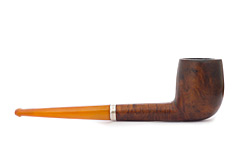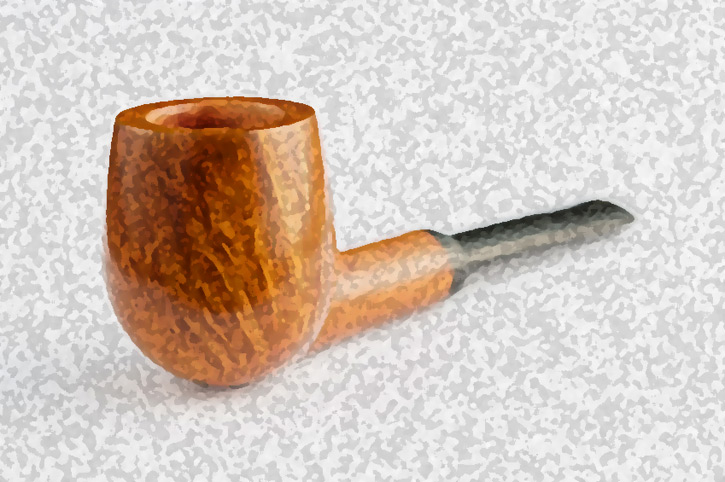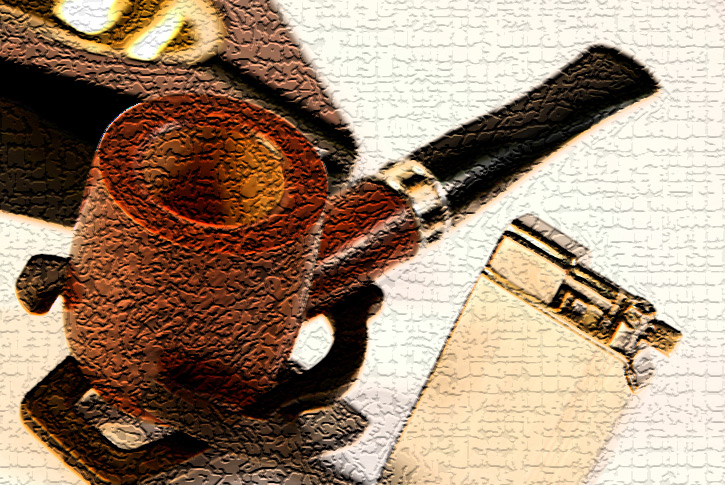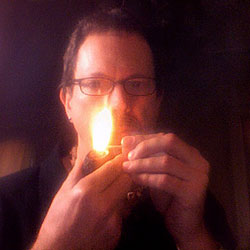G. L. Pease
 In the (somewhat more than) three decades I’ve been accumulating pipes — I choose the word purposefully to distinguish the briar aggregation that currently shares my residence from the purposeful, themed groupings curated by more deliberate and true collectors — I’ve found myself attracted at various times to many different shapes, at one time chasing Princes, another bent Bulldogs, or Apples or Blowfish. You get the picture; my tastes are capricious. There have even been moments of attraction to wild freeform pipes that do not adhere to any prescribed taxonomy, though I rarely admit it in public. The result of all these years of accumulation with abandon is that my “collection” is a motley crew of shapes from traditional to modern, the only threads running through it from one end to the other being the word pipe, and that, at least at one time, I was attracted enough to each one to acquire it. If I wanted to elevate it, I suppose I could call it a collection of collections, but even that seems overly lofty.
In the (somewhat more than) three decades I’ve been accumulating pipes — I choose the word purposefully to distinguish the briar aggregation that currently shares my residence from the purposeful, themed groupings curated by more deliberate and true collectors — I’ve found myself attracted at various times to many different shapes, at one time chasing Princes, another bent Bulldogs, or Apples or Blowfish. You get the picture; my tastes are capricious. There have even been moments of attraction to wild freeform pipes that do not adhere to any prescribed taxonomy, though I rarely admit it in public. The result of all these years of accumulation with abandon is that my “collection” is a motley crew of shapes from traditional to modern, the only threads running through it from one end to the other being the word pipe, and that, at least at one time, I was attracted enough to each one to acquire it. If I wanted to elevate it, I suppose I could call it a collection of collections, but even that seems overly lofty.
Throughout, my appreciation for the pure and refined elegance of the simple Billiard has waxed and, mostly, waned. In my early days, all those years ago, emboldened mainly by the neophyte’s enthusiastic but too often blind hubris, I remember telling a friend who collected nothing but the Billiard was “boring;” I liked more interesting shapes. He laughed, and tried to guide me to realize that, in fact, the well-cut billiard could well be the pipe’s most perfect shape, the very quintessence of the pipe. I wasn’t having any. In reflection, now that I may have learned a thing or two, I know that my uninformed statement couldn’t have been more wrong. The Billiard is anything but boring. Neither is it as simple as it may first appear.

It seems I had naïvely dismissed the Billiard as being little more than a couple of cylinders at right angles to each other with a stem stuck in the end of the smaller one. No wonder I thought the shape was boring. It wasn’t until, my old friend’s words echoing in my mind, I really looked at the things, the rich diversity of one of the oldest shapes in the history of the briar pipe, that I began to appreciate it not only for what it was, but for what it wasn’t.
That “cylindrical” bowl is actually far from it. Looking through old catalogues at hundreds of different examples, it becomes clear that those soft curves, anywhere from delicate to voluptuous, are far more defining of the shape than a straight sided cylinder would be. Go too far along the curvy road, and the bowl morphs into that of an Apple or a Brandy, but leave the sides straight, and it’s just …wrong.
And, that right angle thing? Forget it. When the major axis of a straight pipe’s bowl and that of its shank are geometrically perpendicular, the bowl looks like a drunk ready to fall over backwards. A very slight forward tilt, even if it’s only a degree or two, is essential to the shape’s poise. A little more, and the pipe gains thrust, a little velocity; too jaunty, though, it moves towards the Belge. And the shank? It is often cylindrical, but it’s sometimes slightly tapered, or square, or diamond shaped, and the long, elegant, oval-shanked Canadian is just a billiard in a tuxedo.
Because of fairly loose specifications, the Billiard is one of the most versatile shapes, subject to a great deal of freedom in interpretation, and that’s part of its charm. In contrast to a highly constrained shape — the Prince, for example, which if treated with anything more than light-handed variation, transforms into something very much not a Prince — the billiard is very forgiving. Large, or small, long or short, chubby or slender, saddle stem or tapered; all can qualify for the term “classic.” As one of the oldest shapes on the books, it would be tempting to assume that every possible variation has been made, yet new stylistic forms are still being created that may push against the shape’s envelope, but still remain true to its defining outline. So much for being boring.
Why am I going on at such length about Billiards? Because of a newly rekindled appreciation for their simplicity, for their variety, for the purity of their nature as the archetype of the briar pipe, and, mostly, for their beauty. Though my tastes are fairly firmly rooted in the classic shapes, I do appreciate the creativity and playfulness of some of the more sculptural designs. But, occasionally, something emerges from the pipe maker’s folly that looks more like the result of a late-night tryst between a Cylon raider and My Little Pony than a pipe. When it becomes too much work to coerce my thinking in strange ways to embrace or even comprehend a shape that doesn’t speak the word “pipe” to me, or just to try to figure out how I’d hold the thing, my brain begins to throb.

The perfect Billiard is something of an opposing force, a backlash, a remedy to the throbbing. It’s comforting and comfortable. It’s PIPE writ large, reduced to its basic elements, with everything unnecessary cut away, but with impeccable aesthetics. There’s no jutting chin, no bulbous protuberances, no harsh angles, no decorative wings. Its beauty lies in the purity of its voice, the nuances of its line, the subtlety of its curves, its balance. There’s a reason that in many of the old catalogues and shape charts, the billiard and its variants account for roughly half of all the straight shapes. Even when their numbers are added together, the delightful Dublins and Apples remain a distant second. For over a century and a half, the Billiard has reigned as the king of straight pipes.
I’m certainly not abandoning all the other shapes I’ve come to love and accumulate over the years — the Bulldogs, the Princes, the Dublins — or any that might find their way into my racks in the future. But, at a time when so many wild styles are lauded by collectors, it felt like someone had to speak up for the grand old man, give him a little extra time in the sun, and offer a voice to all the closet Billiard fans out there. Long live the Billiard.
Your turn.
-glp
 Since 1999, Gregory L. Pease has been the principal alchemist behind the blends of G.L. Pease Artisanal Tobaccos. He’s been a passionate pipeman since his university days, having cut his pipe teeth at the now extinct Drucquer & Sons Tobacconist in Berkeley, California. Greg is also author of The Briar & Leaf Chronicles, a photographer, recovering computer scientist, sometimes chef, and creator of The Epicure’s Asylum. See our interview with G. L. Pease here. |

















Greg,
Great article – amusing and thought provoking.
I must, however, dissent from your main thesis as I sit here smoking one of Luigi Radice’s reverse calabashes that might be described as a 1/8 bent tomato and has a bowl with wonderful thick walls that produces a wonderfully cool smoke even by the standard of the tobacco in it (your sublime Robusto as so often happens). Which brings me to the core of my antithesis; the shape of the pipe should match its function in meeting the needs of the individual smoker and my requirement is for thick cooling walls of wonderful briar and while the billiard can be thicker or thinner, to meet my preference it would need to be unfathomably huge or impossibly asymmetric. So in the last few of my 35 years of equally haphazard acquisition I have favoured cobras, squashed bulldogs (Peter Heeschen’s one might be a saucer inspired by yourself) and, indeed one of of Soren Refborg’s wildish freehands. Yes, I still love my old billiards but I find I smoke them less and less. Others will, of course have their own preferences many met by billiards but many by all sorts of shapes particularly bent or hooked pipes.
Why is the billiard the archetypical pipe shape? I would contend simply because it is easy to draw and easy to recognise so, apart from Sherlock Holmes calabash (and I will not go into this not being the shape he smoked in the books but probably started in a later play or film) it is the shape used by particularly cartoonists. This is particularly so as they tend to use the pipe as a symbol of a certain “pipes and slippers” conservatism or old fashionedness and while the billiard can be very crisp in design it is comparatively staid.
The billiard is the great classic shape certainly but for me thicker walls please!
Best wishes for the coming year to you all and I hope you and all your North American readers avoid the appalling weather we read is threatening you.
Ed
Good read – thanks!
I’m new to pipes and pipe smoking (just over a year now), and I was initially drawn to shapes other than the straight billiard. It’s a classic silhouette, but I associated it with the old-fashioned, even stodgy, image of pipes and pipe smokers, and looked more toward the flowing lines of bent pipes, calabashes, and churchwardens.
I’ve since come to appreciate the lines of a well-done straight billiard, and added one to my own extremely modest “collection” – and I find myself looking at them more and more as I decide what to add next. Thanks for pointing out some of the subtleties of the shape.
As I’ve gotten older, my racks have become dominated by the billiard and its variants. Sometimes I prefer a lovat, or Canadian, or a pot, or whatever, but they’re all pretty firmly in the billiard family tree.
Great read! I am A fan of the billiard shape! Nothing says pipe smoking to me like a classic, unadorned straight billiard.
Your article reminds me of my collecting habits, eclectic as they have been. But just when I think I have it all figured out, along comes a billiard that may just be the perfect pipe. Think about it, when you reach for a pipe, how often is it going to be a billiard? You might be surprised.
Good article, as always. I am a fan of the billiard family also. Most of my favorite pipes fall into this category.
Form follows function! Billiards (and their derivatives) for me function well and so the form is stripped down classic shaping.
I enjoy seeing artistic designs but, in the end, simple functionality contains its own beauty.
I am another billiard fan. When you add the variants of Canadian and lovat, that covers a majority of my small aggregation of pipes. It’s classic, and therein lies its appeal for me.
Not a straight billiard fan at all. The design just looks too pedestrian to me. My pipe carving friends assure me that carving a true billiard is extremely demanding.
The billiard will the shape for the upcoming 2014 GKCPC Pipe Carving Contest and I am told that the judging is going require that the pipe be a billiard not just some resemblance to one.
Ok, I can agree that for pure functionality a straight pipe is the only way to go. A pipe cleaner goes straight through and the chance of moisture is minimal. And if course, lets not forget ‘Father knows best’
But what about the bent? The bent pipe is my complete favorite, hands down. Yes, I own several straights, Dunhill, Scott Thile, two no-names, and I try to reach for them in my rotation. But it is an effort on my part; more like I should smoke them than I really want to.
The bent is just so comfortable to my jaw and my teeth. It is so easy to light and tamp and relight. True, if you have a poorly made one, it can get moist and if you are unlucky enough to have one where a cleaner doesn’t go through, well, there is some misfortune.
but get a well made one and you can be in tobacco heaven.
To you billiard guys, bless you all. For me, the gorgeous shape and form of a bent sends me to nirvana.
I love billiards. I only smoke straight pipes and quite often find this shape’s purity and minimalism quite commanding.
Makes me want to go out to my shop and make one right now!
My first love, in pipes, was and still is a billiard.A shape you should master, since so many are born from her.She is difficult, simple, yet demanding to create.Once perfected, you never forget all you were put through to create her.Life gets better from knowing this pipe.You can carve thousands of pipes, yet see a glimpse of her every now and then. I’m glad we met.
Pipedreamer, of guild pipes.
Glad to see the billiard getting some love. Great comments! Pipedreamer really captured it. I’ve tried, myself, and failed miserably in making a really nice billiard. In Tom Eltang’s shop, I made an almost pot-like billiard, and when I was done shaping, Tom looked at it critically (his eye is amazing, and he taught me a great deal about “seeing” the briar and the shapes within it), and said simply, “Pretty nice, but you should remove about 1/2 mm of wood here – and took it to the disk. Sure enough, that tiny change made a huge difference. It really made me appreciate the complexity of “simple” shapes.
I still don’t own even one true, straight-all-around billiard, but I’ve got several that are close- a lovat, a bent apple, Dublin etc. I am more of a curved pipe guy for many different reasons. You don’t have to clean a curved pipe as often, you can see the bowl better while you are smoking, and while I continue to find reasons to not smoke while driving- imagine that pipe in the even of an accident ramming into the back of your throat. Ditto for taking a fall while walking. I’m not a safety nut, but it’s worth considering.
Billiards often have smaller bowls, so if you like Virginias and vapers, you might want one. I’ve gotten attracted to them for that reason, and also as a reaction against my own natural tendency towards curvy, droopier ones.
I do take exception to the idea however that the billiard is the quintessential pipe style. It is if you are a 20th century kind of guy. Vintage modern marketing definitely bears that out- I think the Brits, Dick Van Dyke, and Bob Dobbs of the Church Of The SubGenius back that image. But if you have a love for the 19th century, and you go through the images of day from newspapers (woodcuts etc) you will see that the curvy pipe stem predominates.
My first pipe, purchased in 1963, was a billiard. I guess it was the archetypal “pipe” to my youthful eye. Since then my “collection”, has also become a “Motley Crew”, but billiards probably still outnumber any other shape.